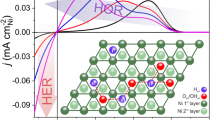Abstract
In this paper the thermodynamics of mixing are applied to account for the independence of the discharge potential of the nickel hydroxide electrode as a function of nickel oxidation state. The constant potential region is considered to arise from the formation of a pair of co-existing solid solutions having a composition predetermined by the magnitude of the interactions between the oxidized and reduced species. From considerations of the excess-energy terms, it can be shown for a symmetrical potential/ composition profile, that the constant potential region is identical with the standard potentialE 0. The influence of asymmetry on the changes inE 0 are discussed. Consideration has also been made of the influence of dissociation of oxidized and/or reduced species on the potential determining equations. The removal of n-type defects from the nickel(II)-rich phase on discharge is considered to be responsible for the observed secondary discharge plateau at potentials ∼ 300 mV more cathodic than normal. This non-equilibrium behaviour can be explained in terms of a mixed pn-semiconducting material.
Similar content being viewed by others
Abbreviations
- E :
-
electrode potential at constant pH(V)
- E 0 :
-
standard electrode potential (V)
- R :
-
the gas constant (J K−1 mole−1)
- F :
-
the Faraday constant (C g-equiv−1)
- T :
-
the absolute temperature (K)
- aH+ :
-
proton activity in the electrolyte
- a z :
-
activity of oxidized species z
- a y :
-
activity of reduced species y
- μH+:
-
chemical potential of the proton
- μ e :
-
chemical potential of the electron
- μ oz :
-
standard chemical potential of species z
- μ z :
-
chemical potential of species z
- μ oy :
-
standard chemical potential of species y
- μ y :
-
chemical potential of species y
- μ H,e :
-
chemical potential of the proton/electron pair
- x y orx :
-
mole fraction of reduced species y
- x z :
-
mole fraction of oxidized species z
- G M :
-
total free energy of mixing (J mole−1)
- G R :
-
free energy of reaction (J mole−1)
- G I :
-
free energy of mixing under ideality (J mole−1)
- G E :
-
excess free energy (J mole−1)
- A,A i andB i :
-
interaction energy parameters (J mole−1)
- x u :
-
mole fraction of y in co-existing phase u
- x v :
-
mole fraction of y in co-existing phase v
- γ y :
-
activity coefficient of undissociated reduced species y
- γ z :
-
activity coefficient of undissociated oxidized species z
- γ ±y :
-
mean ionic activity coefficient of y
- γ ±z :
-
mean ionic activity coefficient of z
- γ υy :
-
activity coefficient of y in phase u
- γ uz :
-
activity coefficient of z in phase u
- γ vy :
-
activity coefficient of y in phase v
- γ vz :
-
activity coefficient of z in phase v
- I :
-
current (A)
- S:
-
cross-sectional area (cm2)
- L:
-
conductor length (cm)
References
P. C. Milner and U. B. Thomas in ‘Advances in Electrochemistry and Electrochemical Engineering’ Vol. 5, Interscience, New York (1967) p. 20.
H. Bode, K. Dehmelt and J. Witte,Electrochim. Acta 11 (1966) 1079.
Idem, Z. Anorg. Chem. 366 (1969) 1.
O. Glemser and J. Einerhand,Z. Anorg. Chem. 261 (1950) 26.
G. W. D. Briggs and W. F. K. Wynne-Jones,Trans. Faraday Soc. 52 (1956) 1260.
Idem, Electrochim. Acta 7 (1962) 241.
E. M. Kuchinskii and B. V. Ershler,Zh. Fiz. Khim. 20 (1946) 539.
G. W. D. Briggs and M. Fleischmann,Trans. Faraday Soc. 67 (1971) 2397.
K. Takahashi, S. Yoshizawa and A. Kozawa, ‘Electrochemistry of Manganese Dioxide and Manganese Dioxide Batteries in Japan’2 (1971) 51, US Branch Office, Electrochem Soc., Japan.
B. E. Conway and E. Gileadi,Canad. J. Chem 40 (1962) 1933.
R. Barnard, C. F. Randell and F. L. Tye,J. Appl. Electrochem.
F. P. Kober,J. Electrochem. Soc. 112 (1965) 1066.
Idem, ibid 114 (1967) 215.
I. K. Kuchkaeva, I. S. Shamina, P. N. Bityutskii and L. A. Chetovskaya,Zhur. Priklad. Spektroskopii 17 (1972) 921.
R. Barnard and G. T. Crickmore, published results.
I. S. Shamina, O. S. Malandin, S. M. Rakhovskaya and L. A. VereshchaginaElectrokhim. 10 (1974) 1571.
S. Atlung,MnO 2 Symposium 1 Cleveknd Ohio, JECS (1975) p. 47.
J. H. Hildebrand and R. L. Scott, ‘The Solubility of Non-Electrolytes’, Reinhold, New York (1948).
E. A. Guggenheim, ‘Mixtures’ Oxford, London (1952).
R. Barnard, G. T. Crickmore, J. A. Lee and F. L. Tye,J. Appl. Electrochem.
W. L. Bragg and E. J. Williams,Proc. Roy. Soc. Sen. A145 (1939) 699.
A. V. Joshi, ‘Fast Ion Transport in Solids’ Edited by Van Gool, North Holland Publishing Co. p. 173.
J. B. Wagner, ‘Fast Ion Transport in Solids’ Edited by Van Gool, North Holland Publishing Co. p. 489.
L. N. Sagoyan, Yu. M. Gulyamov, P. Z. Barsukov and V. E. Dmitrenko,28th I.S.E. Meeting Bulgaria (1977) Extended Abstract 82.
W. M. Latimer, ‘The Oxidation States of the Elements and their Potentials in Aqueous Solutions’ Prentice Hall, New Jersey (1952).
B. J. R. Hodge, R. Bonnaterre and F. Putois, ‘Power Sources 5’ edited by D. H. Collins, Academic Press, New York (1975) p. 219.
M. Pourbaix, ‘Atlas d'Equilibres Electrochimiques’ Gauthier-Villars (1963).
F. A. Lewis, ‘The Palladium/Hydrogen System’, Academic Press, London (1967).
F. L. Tye,Electrochim. Acta. 21 (1976) 415.
M. L. Hitchman,J. Electroanalyt. Chem. 85 (1977) 135.
R. S. Crandall, P. J. Wojtowicz and B. W. Faughnan,Sol. State Comm.,18 (1976) 1409.
Author information
Authors and Affiliations
Rights and permissions
About this article
Cite this article
Barnard, R., Randell, C.F. & Tye, F.L. Studies concerning charged nickel hydroxide electrodes. II. Thermodynamic considerations of the reversible potentials. J Appl Electrochem 10, 127–141 (1980). https://doi.org/10.1007/BF00937346
Received:
Issue Date:
DOI: https://doi.org/10.1007/BF00937346




